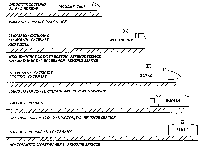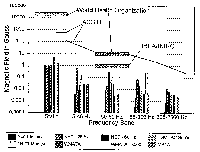
This executive summary describes the final report for this project.
Fred M. Dietrich, William E. Feero and William L. Jacobs, under contract to John A. Volpe National Transportation Systems Center, Cambridge, MA 02142.
A series of studies was conducted to gather comprehensive magnetic and electric field data on a variety of electrified transportation systems. With such data, emerging technologies could be adequately and equitably compared to existing technologies and other sources of magnetic and electric fields. This was done to determine if significant changes in public exposure to electric and magnetic fields would result from the introduction of the new maglev technology.
The systems studied included the German TR-07 maglev [1], Amtrak Northeast Corridor (NEC) [2] and North Jersey Transit (NJT) trains, on the 60 Hz ac power segment of the North Jersey Coast Line (Long Branch) [2], Washington, DC Metrorail (WMATA) [4] and the Boston, MA (MBTA) [5] transit systems; and the French TGV-A high speed rail system [3]. Figure 1 depicts the sequence of reports containing the results of the studies on various transportation systems. Pertinent information about the location of the tests and power delivery technology employed in each system is shown as well. Technical characteristics of these systems and their impact on field characteristics are discussed in more detail in Section 2 of this report.

|
The magnitude of the magnetic fields found during the TR07 measurements taken at the Emsland, Germany test track did not demonstrate a significant difference from other environmental magnetic fields from power lines and electrical equipment [1]. However, the frequency characteristics of the magnetic fields produced by the TR07 system were different from those reported for other common magnetic field sources. Specifically, magnetic fields produced by common sources like transmission lines and most other power delivery and utilization equipment are predominantly single-frequency fields at the established power frequency of 60 Hz in North America or 50 Hz in Europe. The TR07 data was more complex because it contained a broad low frequency spectrum. In the initial report on the TR07 maglev the magnetic fields were compared to the single frequency magnetic field reported in close proximity to transmission and distribution lines and near appliances. However, a cautionary note pointed out that the comparison was not valid if any parameter but magnitude was important. Figure 2 gives a graphical perspective of how the magnetic fields measured on the TR07 would compare to magnetic fields near transmission lines, distribution lines, and household appliances [6]. It was plotted as a function of frequency bands which were used to characterize the TR07 measurements. Transmission line currents contain less than one percent of harmonics and therefore are well characterized as generating principally 50 or 60 Hz fields. With the recent emergence of the widespread use of solid state control devices, distribution lines and household appliances now may generate more than just 50 or 60 Hz magnetic fields. To fairly compare the magnetic field data of the yet to be commercially used TR07 with distribution line and appliance magnetic field data, the "blanks" in Figure 2 indicate that little magnetic field data has been recorded in these frequency sub-bands for these recently introduced electrotechnologies [7].
In fact, it can be safely assumed that attractive Electro Magnetic Suspension (EMS) maglev systems of the Transrapid TR07 design do not present any unique magnetic field environment that is not already encountered in a number of different electrified transportation systems within the United States. Note that other design concepts for achieving magnetic levitation, such as the repulsive superconducting Electro Dynamic Suspension (EDS) concepts, may produce significantly higher magnetic fields and have not been addressed in this study.
The subsequent studies of other electrified transportation systems [2,3,4,5] were an attempt to collect EMF data which at least permitted comparison within a specific technology. By using a version of the same high quality instrumentation (enhanced for portability) that was used for maglev measurements, multiple frequency magnetic fields that existed in other rail technologies were recorded. This report examines the data sets together to demonstrate how the Transrapid TR07 magnetic field characteristics, both onboard and adjacent to the operating facilities compare to similar measurements on all the other electrified transportation technologies studied.
The following sections in this report present a concise by detailed discussion of relevant data. The data will be cross-compared for surveyed electrotechnologies at key locations (in the passenger sections, in the operator's compartments, at the wayside, on the passenger platforms, near the substations supplying power to the trains, and in the operator control rooms), and for representative operating conditions. The datasets collected in the passenger compartments of the different electrified transportation systems give an overview of the general findings of these studies.
Figure 3a is a depiction of the maximum magnetic fields measured on the inter-city trains studied. The magnetic field is presented on a log scale which makes it possible to see both the low-level fields and the higher-level fields. Figure 3b is a similar plot for the urban transit systems that were monitored. As can be seen from this figure, the magnitudes of the Transrapid TR07 magnetic fields are reasonably typical of magnetic fields found on electrified transportation systems. Their frequency characteristics are not greatly different from the frequency characteristics found when looking at electrified transportation technology as a whole. In fact, it can be inferred from this figure, and the report, that the Transrapid TR07 maglev system does not represent a unique electro-magnetic environment and that is comparable to EMF characteristics measurable in a number of different electrified transportation systems within the United States.
As shown in Figure 4, none of the magnetic fields measured in or near any of the electrified transportation systems surveyed exceed the threshold limit value (TLV) of any existing standard or guidelines for occupational or public exposure. This figure shows with bar graphs the maximum magnetic fields found at the height of the torso of adult humans, seated at 0.6 m (2 ft) or standing 1.6 m (5.3 ft). The American Conference of Governmental Industrial Hygienists (ACGIH) [9] guidelines has a caveat restriction that may require further review. ACGIH suggests a further lowering of the TLV by a factor of 10 to ensure non-interference with medical devices, in particular cardiac pacemakers. Figure 4 suggests that the reduced TLV may be exceeded at a small localized area in the center of WMATA 3000 series cars. However, compliance cannot be determined because the guideline fails to address treatment of spatial non-uniform fields, highly variable in time (transients), and fields with multiple frequency components. Magnetic fields at other locations and in other transportation systems are well below the reduced TLV recommended for pacemaker wearers. In no case were magnetic fields measured in or near the Transrapid TR07 maglev systems found to be within an order of magnitude of the most restrictive interpretation of any of these standards.

|